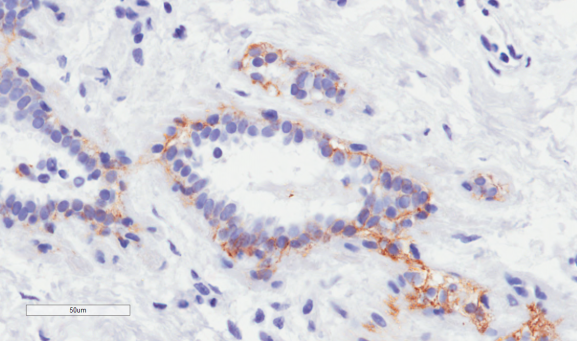![绝对抗体/抗erbB-2(Her-2/neu)[4D5-8(曲妥珠单抗)]/50μg/Ab00103-16.0](https://www.ebiomall.cn/images/no_picture.gif)
UniProt Accession Number of Target Protein: P04626
Alternative Name(s) of Target: Metastatic lymph node gene 19 protein (MLN 19); Proto-oncogene Neu; Proto-oncogene c-ErbB-2; Tyrosine kinase-type cell surface receptor HER2; p185erbB2; p185HER2; CD340; EGFRImmunogen: A431 cells (human epidermoid carcinoma) (over)expressing EGFR.
Specificity: Oncogenic protein Her-2/neu (erbB-2), a member of the family of epidermal growth factor (EGF) receptors, overexpressed in 30% of invasive breast cancers and 70% of ductal carcinomata in situ, in a small percentage of melanomas, and in other malignancies originating from various organs, including ovary, kidney, colon, and bladder.
Application Notes: This antibody binds to erbB-2/Her-2/neu has therapeutic indications particularly in the treatment of breast cancer (c.f. Herceptin). It can also be used to detect HER-2 by flow cytometry or IHC (Glazyrin 2007).
Antibody first published in:Carter P, Presta L, Gorman CM, Ridgway JB, Henner D, Wong WL, Rowland AM, Kotts C, Carver ME, Shepard HM.Humanization of an anti-p185HER2 antibody for human cancer therapy.Proc Natl Acad Sci U S A. 1992 May 15;89(10):4285-9.PMID:1350088Note on publication:Describes the humanisation of the antibody (also known as Herceptin), shows it recognised HER2 in a wide variety of immuno-assays.


Immunohistochemical staining of paraffin embedded human breast tissue using anti-erbB-2 antibody (Ab00103) 4D5-8 (trastuzumab) Anti-erbB-2 (Her-2/neu) staining of paraffin embedded human breast tissue using the rabbit-chimeric version of 4D5-8 (trastuzumab) (Ab00103-23.0). Antigen retreival was achieved by microwaving in citrate buffer (pH6), followed by blocking with protein block serum-free buffer (Dako, cat. #X0909). Primary antibody incubation with Ab00103-23.0 was carried out at 4 µg/ml for 30 minutes. Samples were then incubated with an anti-rabbit IgG HRP secondary antibody (Dako cat#K4009) for 20 mins followed by DAB (3,3′-diaminobenzidine), and counter-staining with haemotoxylin. Weak membrane staining exclusively of ductal epithelial cells may be observed. Recommended concentration, 4-6 µg/ml.



